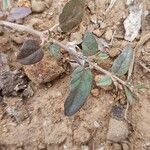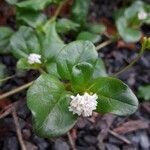Herbs ephemeral to perennial. Stems prostrate, radiating from taproot, to 50 cm, most parts eglandular-puberulent. Petiole to 1 cm; leaf blade 1-2.5 × 0.4-1.5 cm, abaxially conspicuously pale, base rounded to cuneate, margin entire, apex rounded to subacute. Inflorescences mostly axillary, 2-5-flowered umbels, sometimes gathered into cymes, to 2 cm. Pedicel to 1 mm. Perianth limb white, pink, or pale purple, to 1 mm. Stamens (1 or)2(or 3). Anthocarp clavate, 3-3.5 mm, 5-ribbed, sparsely puberulent, sometimes with ± sessile glands.
Perennial, glandular-hairy herb; stems herbaceous, prostrate from a thickened taproot. Leaves: lamina ovate, 4–23 mm long, usually oblique at base, undulate margin, obtuse or acute at apex; petiole 1–12 mm long. Inflorescence axillary; peduncle 1.5–5 cm long; basic unit a several flowered glomerule; flowers subsessile. Perianth base sparsely glandular-hairy; limb broadly campanulate, c. 1.5 mm long, white. Stamens 4. Fruit ellipsoidal, 2.5–3 mm long; ribs and furrows sparsely glandular hairy.
A herb. It has many branches. The branches appear each year from a thickened rhizome or underground stem. The stems are slender. They are thickened at the nodes. The leaves are in unequal pairs at each node. The leaves are 2 cm long and have glands. The flowers are in clusters or 2-6. They can be white or pink. The fruit are 3-4 mm long.
Leaves 0.5–2.5(4) × 0.15–1.2 cm., ovate to lanceolate, base rounded to truncate, apex obtuse to acute, often mucronate, sparsely puberulous to glabrous, glandular punctate, subsessile or with petioles up to 0.7 cm. long.
Inflorescences cymose or pseudo-umbellate, axillary, often appearing crowded out of axil by axillary shoot, 1 cyme per peduncle; peduncles up to 10 mm. long, slender, glabrescent to glabrous.
Flowers usually 2–4 per cluster sometimes up to 6–7 in cymes towards tips of shoots, more rarely solitary; pedicels to 1.5 mm. long (sometimes longer in fruit), glabrescent to glabrous.
Perianth 1.5–2.5(3) mm. long, glandular-pubescent to glabrescent, lower portion 5-ribbed, upper portion 0.5–1.0 mm. long, campanulate, white, pink or mauve.
Bracteoles 0.5–1.2 mm. long, linear-lanceolate, usually ciliate, glandular-punctate, crisped-puberulous (particularly around margins) to glabrescent.
Prostrate herb. Leaves small, usually shorter than 25 mm. Inflorescences axillary clusters or short cymes up to 25 mm long. Flowers pink.
Anthocarps 3–3.5 × 1.5–2 mm., clavate to fusiform, apex rounded, glandular pubescent; ribs 5, smooth, more or less glabrous.
Stems prostrate, sparingly to much branched, slender, puberulous or pubescent to glabrescent.
Ovary 0.3–0.5 mm. long, glabrous; style 0.6–1.2 mm. long.
Stamens 1–2, subequal, included, 0.6–0.8 mm. long.
Annual herbs with thickened roots.



